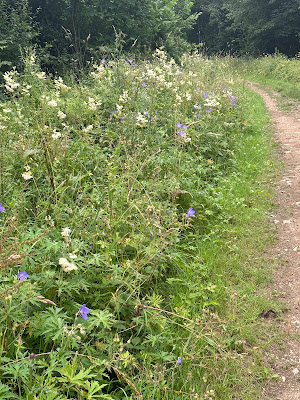I wonder if you wonder what I do in my spare time. I will tell you. I spend way too much of it phoning, texting, messaging, filling out contact forms, and WhatsApping, trying to get taxis to transport Rojita and her sidekick, the small red backpack in which are many of my survival items: coffee mix, sugar, peanut butter, jam, apples, lemons, things like that, which most travelers do nicely without. Then there is reading the daf and a commentary, the Spelling Bee, which I have been falling down on lately, Quordle, reading up on the next day's route...well, not so much up to now, but will for the Thames Path, making sure the GPS and phone are properly loaded with the relevant gpx data, grocery shopping, laundry, unpacking and packing, stuff like that. It is a busy life out here on the trail!
Today I did a marvelous circular walk around Cirencester which took in the Sapperton Canal (If you click on the link, you can read all and I mean all about it; not sure I can!)
Today the canal looks like this:
And like this:
As I was contemplating the now empty ditch, a lady walking her dog came by and told me that the canal had been made obsolete by the railway not very long after it was finished, a sad end to a five-year construction project that yielded a tunnel more than 1/2 a mile long.
Leaving the canal, I had a choice (as I had many times today and every day, it seems):
Upper path or lower? (I'll leave you hanging on that one.)
Continuing my peregrinations, I was stopped in my tracks by a Danger: Do not enter sign with a list of weird alternate routes one could take instead of the one I had to take to get to the road just up ahead. What to do? There was the whirring sound of electric saws and men at work in a barn-like structure. "Maybe I should ask if I might go through to the road," I mused. "No, why ask? They could say no. I will be very quiet and just tiptoe by." And so I was and so I did.
Cirencester, called Corinium back in the day, offers many Roman relics, such as this amphitheatre, which, to me, looks like a series of mounds:
But unlike other sites, it is open 24/7 and does not require an entry ticket.
Same with this obelisque:
which, if it ever had anything carved on it, no longer does. I was surprised to see this because I see obelisque I think Egypt.
Keeping with the Roman theme, The Roman Road is today the A433:
Business don't want to miss out on the Roman connection either:
Is there a walk in the Cotswolds without sheep?
or flowers by the roadside?
And who would not be delighted to know that grass is adding biodiversity to the college campus?
Back in town, I visited the Corinium, but I gotta tell you, archeology does not float my boat (as compared to the RNLI duck boats, which most certainly do). Let's just say it tends to over speculate.
To wit: you see this Roman soldier:
OK, this is his story as told on the accompanying plaque:
Late Roman Cavalryman
Life size figure of a 4th century Roman cavalryman. His weapons and clothes are based on excavated examples from Britain and the western provinces.
The number of military-style objects found in Cirencester suggests that soldiers of this type may have been a familiar sight in 4th century Corinium.
Don't even get me started on the problems with that description.
Now, here is a close-up of his shoes:
David Harpin, I ask you, "Is this for real, genuine, 4th century Roman cavalry footgear?"
Those complaints expressed, I will say that the Corinium is an inviting and well-done museum of its kind: light, spacious, easy to navigate, displays not crowded and so on.
I was way more impressed by this sculpture in Cirencester Park the title of which you will never ever guess:
Are you thinking maybe, "Fantasy of Horse wanting to be Ballerina?" or "Horse in the style of El Greco Lite?" or maybe even, "Equine Dream?" Wrong, wrong, and wrong again! It is called "Still Water 2019." Oh, of course! It must be named after the plaque the muzzle is resting against so that Horse-Head does not fall in and drown!
I lied. I had not finished with the Monarch's Way! I walked some of it yesterday, and a different stretch today. It never ends! Today I headed out late, 7:00 a.m. because the gardens I wanted to see at Cerney don't open until 10:00 and it was less than six miles distant. Little did I know that I could have gone in at any time, but more of that later.
With the city still asleep, I could finally get a decent shot of the famous sculpture outside the Cathedral:
Maybe it is not famous, but it is prominent!
Some people have super sensible solutions to real world problems:
Is it not wonderful or what that the colors remain even though the name changed! Everyone is a winner, although maybe Powell got the best of the deal.
It is hard to tell if one should feel protected or threatened:
On the map, the route today ran along a river—and it does—but the river is invisible from the path except here:
where there is a little break in the bushes so you can take a peek.
No matter what anyone says, this is mean!
And this is a) enigmatic b) insane c) idiotic d) funny e) all of the above f) none of the above:
Shortly before reaching the gardens one comes to a church:
Arriving at the Cerney House and Gardens (a misnomer because into the house you cannot go) you come to an open area, no gate, with a sign telling you that you can deposit the £6 entry fee into the box or pay when you get to the cafe. The whole place works on an honesty system: plant sales, containers, entry, tea and cakes. It is all very sweet and truly welcoming. I arrived before 10:00 and just went in.
The garden, being a walled garden, is not large, but it is lovely and there are some peripheral walks.
A view:
There was a whole row of these smoke bushes and roses:
The medicinal herb gardens were fun! Here are two examples:
Parsley
Petroselinum Crispum
Part used: Leaf, root (second year old)
Traditional Uses:
Used as a diuretic to treat gout, jaundice, rheumatism and remove 'gravel and stones' from the kidneys. Parsley tea was given to soldiers in the First World War for dysentery.
Medicinal discoveries:
Scientific experiments have shown that root extract can decrease uric acid content, which would explain why it was used for treating gout.
Yarrow
Achillea Millefolium
Achillea is named after Achilles, the hero of Greek mythology, who used yarrow to treat his soldiers. It is known as herba militaris in Latin and woundwort, in English.
Yarrow ointment is much recommended because of the property to staunch bleeding. Because of this property is has also used for heavy and painful periods.
Yarrow was one of the many herbs that were added to beer before hops came to dominate brewing. These plants served a dual purpose, preserving the beer by inhibiting microbes and adding a bitter flavour. This points to a bacterial action of yarrow, which is useful in wound healing.
Outside of the garden is a stumpery:
Not dignified enough for Sezincote, however, whose stumps met different ends.
On the way back to Cirencester, the GPS said, "turn left." I looked and beheld:
and he had several friends nearby. "For real?" Not that Bruiser and buddies were snorting or pawing the ground, but visions of that guy who went to China to collect botanical specimens and ended up being crushed to death by a bull in a pit flashed through my head. I stuck to my path and at the end saw that that the diversion away from the pasture had been posted in that direction, but some clown neglected to post it in the other direction. You always have to be on your toes.

























No comments:
Post a Comment